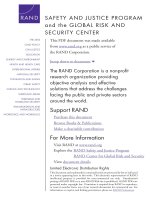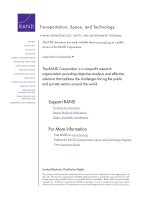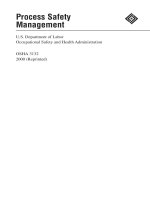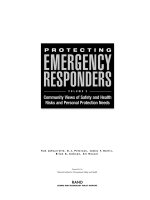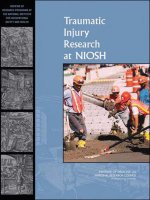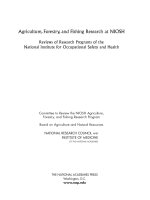Child Internet Safety summit online safety and inspection
Bạn đang xem bản rút gọn của tài liệu. Xem và tải ngay bản đầy đủ của tài liệu tại đây (1.08 MB, 26 trang )
Online safety and inspection
David Brown HMI
@DavidBrownHMI
Friday 3 July 2015
Child Internet Safety summit
Online safety survey:
March 2015
March 2015 – online safety survey
During March 2015 a survey on online safety practice was
carried out during all HMI-led S5 school inspections. A total
of 39 primary and 45 secondary schools were involved.
During their inspection inspectors discussed online safety
issues in the school with:
senior leaders
groups of teachers
governors
groups of students
Online safety and inspection
Online safety policy
5% of schools did not have an online safety policy
students, and to a lesser extent governors, are not always aware of this
policy
Online safety and inspection
Online safety policy
a large majority of schools do not involve students in designing their online
safety policy
Online safety and inspection
Online safety policy (primary)
policies are mainly written by senior leaders, teachers and governors
student involvement in writing online safety policies remains low
Online safety and inspection
Online safety policy (secondary)
the involvement of the wider school community in writing online safety
policies remains low
Online safety and inspection
Acceptable use policy
student responses indicate that less than half of schools implement
acceptable use policies for technology use in school
Online safety and inspection
The online safety curriculum
assemblies and computing/ICT lessons are the main focus for online safety
teaching for many schools
PHSE lessons play a significant role in the delivery of online safety
Online safety and inspection
Online safety teaching
over 25% of secondary students cannot recall if they have been taught
about online safety over the last 12 months
Online safety and inspection
Online safety teaching
just over a quarter of secondary students have less confidence in their
teacher’s knowledge of online safety issues
Online safety and inspection
Online safety training for staff
training can be inconsistent, and what senior leaders might see as training
may not be reflected by staff
Online safety and inspection
Online safety training for staff
confidence in recognising, responding to and resolving online safety issues is
slightly stronger in secondary schools than in primary schools
Online safety and inspection
Bring your own (device)
a significant majority of schools do not allow the use of personal devices
personal devices are more likely to be allowed in secondary settings
Online safety and inspection
Reporting online safety issues
senior leaders
staff
governors students
Online safety and inspection
Inspection of education and
online safety from September
2015
Inspecting safeguarding
Online safety and inspection
In relation to children and young
people, safeguarding and promoting
their welfare is defined in ‘Working
together to safeguard children’
as:
protecting children from
maltreatment
preventing impairment of children’s
health or development
ensuring that children are growing
up in circumstances consistent with
the provision of safe and effective
care
taking action to enable all children
to have the best outcomes.
Inspection and safeguarding
Online safety and inspection
Definition of safeguarding (extract paras
10 and 11)
Safeguarding action may be needed to protect children and
learners from:
bullying, including online bullying and prejudice-based bullying
the impact of new technologies on sexual behaviour, for example
sexting
Safeguarding is not just about protecting children, learners and
vulnerable adults from deliberate harm, neglect and failure to act.
It relates to broader aspects of care and education, including:
online safety and associated issues
The term ‘online safety’ reflects a widening range of issues
associated with technology and a user’s access to content, contact
with others and behavioural issues.
Online safety and inspection
The signs of successful safeguarding
arrangements (extract para 13)
In settings that have effective safeguarding arrangements, there
will be evidence of the following:
Adults understand the risks posed by adults or learners who use
technology, including the internet, to bully, groom, radicalise or
abuse children or learners. They have well-developed strategies
in place to keep children and learners safe and to support them
to develop their own understanding of these risks and in
learning how to keep themselves and others safe.
Leaders oversee the safe use of technology when children and
learners are in their care and take action immediately if they are
concerned about bullying or children’s well-being. Leaders of
early years settings implement the required policies with regard
to the safe use of mobile phones and cameras in settings.
Online safety and inspection
Inspecting how effectively leaders and
governors create a safeguarding culture
in the setting (extract para 18)
Inspectors will want to consider evidence that:
staff, leaders and managers understand the risks posed by
adults or young people who use the internet to bully, groom or
abuse children, young people and vulnerable adults
there are well-developed strategies in place to keep learners
safe and to support them in learning how to keep themselves
safe
staff, leaders and managers oversee the safe use of electronic
and social media by staff and learners and take action
immediately if they are concerned about bullying or risky
behaviours
Online safety and inspection
Arriving at judgements about safeguarding
arrangements (extract para 34)
Online safety survey
Inspectors will make a judgement on the personal development,
behaviour and welfare of children and learners by evaluating,
where applicable, the extent to which the provision is successfully
promoting and supporting children’s and learners’ safety.
Online safety and inspection
Arriving at judgements about safeguarding
arrangements (extract para 34)
In order to make this judgement, inspectors will consider, among
other things, children’s and learners’ understanding of how to
keep themselves safe from relevant risks such as exploitation
and extremism, including when using the internet and social
media.
Inspectors should include online safety in their discussions with
pupils and learners (covering topics such as online bullying and
safe use of the internet and social media).
Inspectors should investigate what the school or further
education and skills provider does to educate pupils in online
safety and how the provider or school deals with issues when
they arise.
Online safety and inspection
Grade descriptor for personal development,
behaviour and welfare (extract)
Similar text is found in the outstanding descriptor in the inspection
handbooks for maintained schools (including free schools and
academies), for non-association independent schools, and for
further education and skills providers:
Pupils/learners work hard with the school/provider to prevent all
forms of bullying, including online bullying and prejudice-based
bullying.
Pupils/learners have an excellent understanding of how to stay
safe online, the dangers of inappropriate use of mobile
technology and social networking sites.
Online safety and inspection
Leadership and management
Inspectors will always make a written judgement in the section on
leadership and management about the effectiveness of the
arrangements for safeguarding pupils.
Short inspections of good schools will always report on the
effectiveness of safeguarding. If safeguarding is not effective, HMI
will always convert the short inspection to a section 5 inspection.
Online safety and inspection


